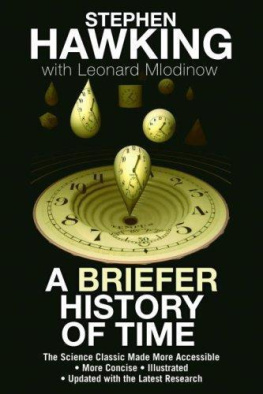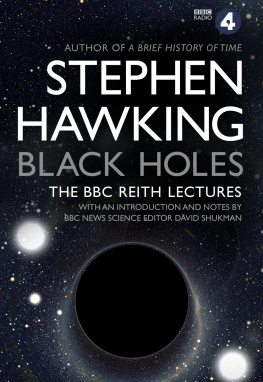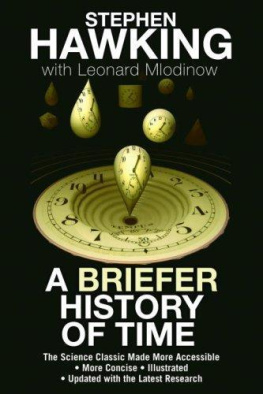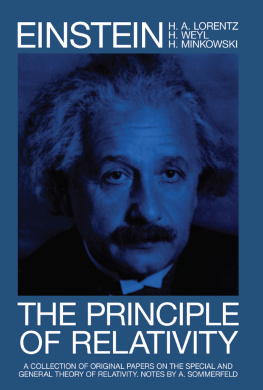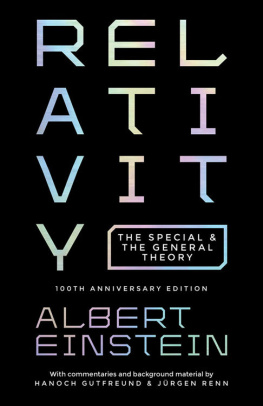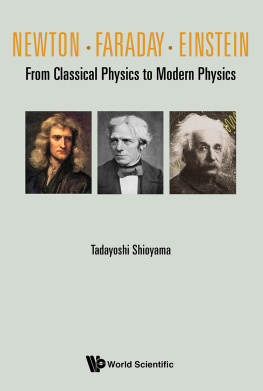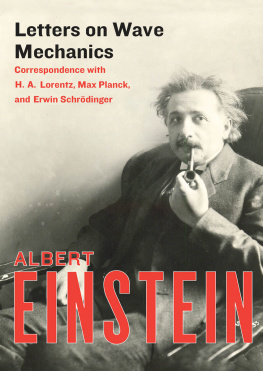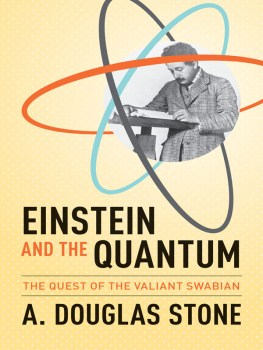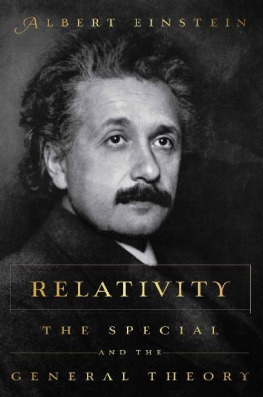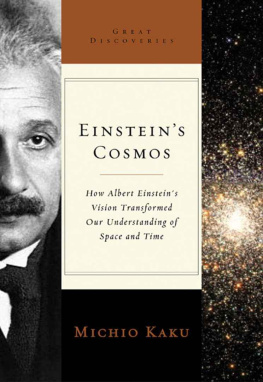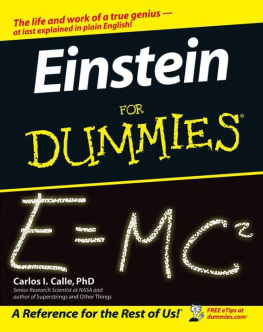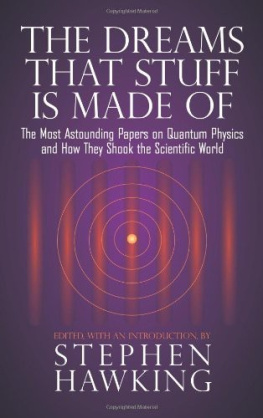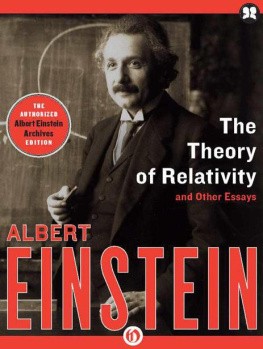A STUBBORNLY
PERSISTENT
ILLUSION
A STUBBORNLY
PERSISTENT
ILLUSION
THE ESSENTIAL SCIENTIFIC WRITINGS OF ALBERT EINSTEIN

RUNNING PRESS
PHILADELPHIA LONDON
2007 by Stephen Hawking
All rights reserved under the Pan-American
and International Copyright Conventions
This book may not be reproduced in whole or in part, in any form or by any means, electronic or mechanical, including photocopying, recording, or by any information storage and retrieval system now known or hereafter invented, without written permission from the publisher.
9 8 7 6 5 4 3 2 1
Digit on the right indicates the number of this printing
First paperback edition published in 2009
Library of Congress Control Number: 2007935658
ISBN-13 978-0-7624-3564-7
Cover design by Bill Jones
Interior design by Bill Jones and Aptara, Inc.
Edited by Jennifer Kasius
with David Goldberg
Typography: Adobe Garamond
This book may be ordered by mail from the publisher.
Please include $2.50 for postage and handling.
But try your bookstore first!
Running Press Book Publishers
2300 Chestnut Street
Philadelphia, PA 19103-4371
Visit us on the web!
www.runningpress.com
TEXT CREDITS
Selections from THE EVOLUTION OF PHYSICS: Reprinted with the permission of Simon & Schuster Adult Publishing Group, from The Evolution of Physics by Albert Einstein and Leopold Infeld. Copyright 1938 by Albert Einstein and Leopold Infeld. Copyright renewed 1966 by Albert Einstein and Leopold Infeld. All Rights Reserved.
Selection from THE MEANING OF RELATIVITY: Courtesy of Princeton University Press.
Autobiographical notes reprinted by permission of Open Court Publishing Company, a division of Carus Publishing Company, Peru, IL, from A. Einstein: Autobiographical Notes translated and edited by Paul Arthur Schilpp, first published in Albert Einstein: Philosopher-Scientist in The Library of Living Philosophers Series Volume VII, (c) 1949, 1951, 1970, 1979 by The Library of Living Philosophers, Inc., and the Estate of Albert Einstein.
Selections from OUT OF MY LATER YEARS: Reprinted with permission from The Philosophical Library, New York.
CONTENTS
A few years ago the world celebrated the 100th anniversary of Einsteins miracle year, the year in which he revolutionized physics in multiple ways with a series of astonishing new ideas that brought about profound changes in the way physicists view the universe. Human intuition tells us that space is a stage upon which the events of our lives play out, that time is governed by a universal clock. But in 1905 and the decade that followed, Einstein showed that space and time do not have identical meanings for observers sitting in a chair and those flying on a plane, those orbiting with us on earth, those having tea somewhere in the Virgo cluster, or those being sucked into a black hole.
Einsteins ideas once stunned physicists. Today they are automatically incorporated into the equations and formalism learned by every undergraduate physics major. As long as those ideas stand up, Einstein wrote in one of the articles in this collection, the Germans will call him a German savant, and the English will call him a Swiss Jew. But if his ideas were ever discredited, he wrote, he would be a Swiss Jew for the Germans and a German savant for the English. Today there are few physicists left who remember Einstein as a living, breathing, and witty human being. Today his ideas of space and time intertwined are ingrained in popular culture, and described by writers several generations down. But the most lucid, not to mention entertaining, proponent of Einsteins ideas has always been Einstein himself.
As he describes in this volume, Einsteins 1905 special theory of relativity grew out of a simple observation. The theory of electromagnetism discovered by James Clerk Maxwell in the 1860s showed that whether you are moving toward or away from a beam of light, the light will always approach you at the same speed. This is not true of our experience in the everyday world. If you race away from an onrushing train you will survive for a few more seconds than if you race toward it (assuming that you dont get the idea to jump sideways). In the former case the trains speed of approach will be the difference between its speed and your speed (relative to the track). In the latter case its speed of approach will be the sum of your speeds. The same, according to Maxwells theory, does not apply to the light emitted from the trains headlamps. How could the speed of light not appear slower in the former case and faster in the latter?
By speed we mean distance traveled divided by the time of the trip. And so, Einstein realized, if we are to take Maxwells theory at face value, we must alter our ideas of space and time. They are not fixed and unchanging, but adjust according to the observer, bending or stretching in just the way necessary to keep the speed of light constant. The same bending and stretching means of course that the speed at which the train itself approaches is also not the simple sum or difference I described above. But at speeds far less than the speed of light the difference in adding and subtracting derived by Einstein has only negligible effect. The same chain of logic, when taken further, requires also the equivalence of mass and energy, the reason that we can have atomic energy, and, unfortunately, atomic weapons. The details of Einsteins reasoning, and the simple algebra behind it, are explained nowhere better than as found here, in Einsteins own words.
Einsteins theory of general relativity also grew from a simple observation. In Newtons laws of motion there appears a quantity called the mass, which determines how easily an object accelerates when a force is applied. A massive truck is far more difficult to bring to speed than a far less massive Volkswagen. In Newtons day three forces were known: electricity, magnetism, and gravity. The resistance to changing velocity in Newtons laws of motion does not depend on which of those forces is applied. But Newton also discovered a law governing one of those forces, the force of gravity. In that law there appears another quantity which determines the amount of gravitational pull an object exerts, and the amount of gravitational pull it feels when in the presence of another object. That quantity is also called the mass. The two definitions of mass play quite different roles, but they are both called mass for good reason: it turns out they are one and the same. Why should they be equivalent? That question, plus Einsteins brilliant logic, led to his realization that the scaffolding of space and time reacts to the presence of matter and energy.
At a time like the present, Einstein wrote, when experience forces us to seek a newer and more solid foundation, the physicist cannot simply surrender to the philosopher the critical contemplation of the theoretical foundations; for, he himself knows best, and feels more surely where the shoe pinches. Einstein was not narrowly interested in science, but also in the philosophy and language of science, and even its ethical implications. Some of his writings on those subjects, too, are included here. And. though Einstein wrote the above words in 1936, today is also a time in which physicists seek a new foundation, and a time in which such metaphysical issues have as much relevance as they did then. Today, since Einstein described space and time as dynamic variables, we see the universe as having not just one, but every possible history. We contemplate not only warped space and time, but whether the universe has additional dimensions. And we speculate about the very meaning of those concepts, and whether they are well defined or only approximate. We seek today a unified theory of all forces, as well as the framework of space and time in which we experience that the universe unfolds. It is a quest of which Einstein would have approved, and for which the remarkable work in this volume provides the foundation.
Next page

